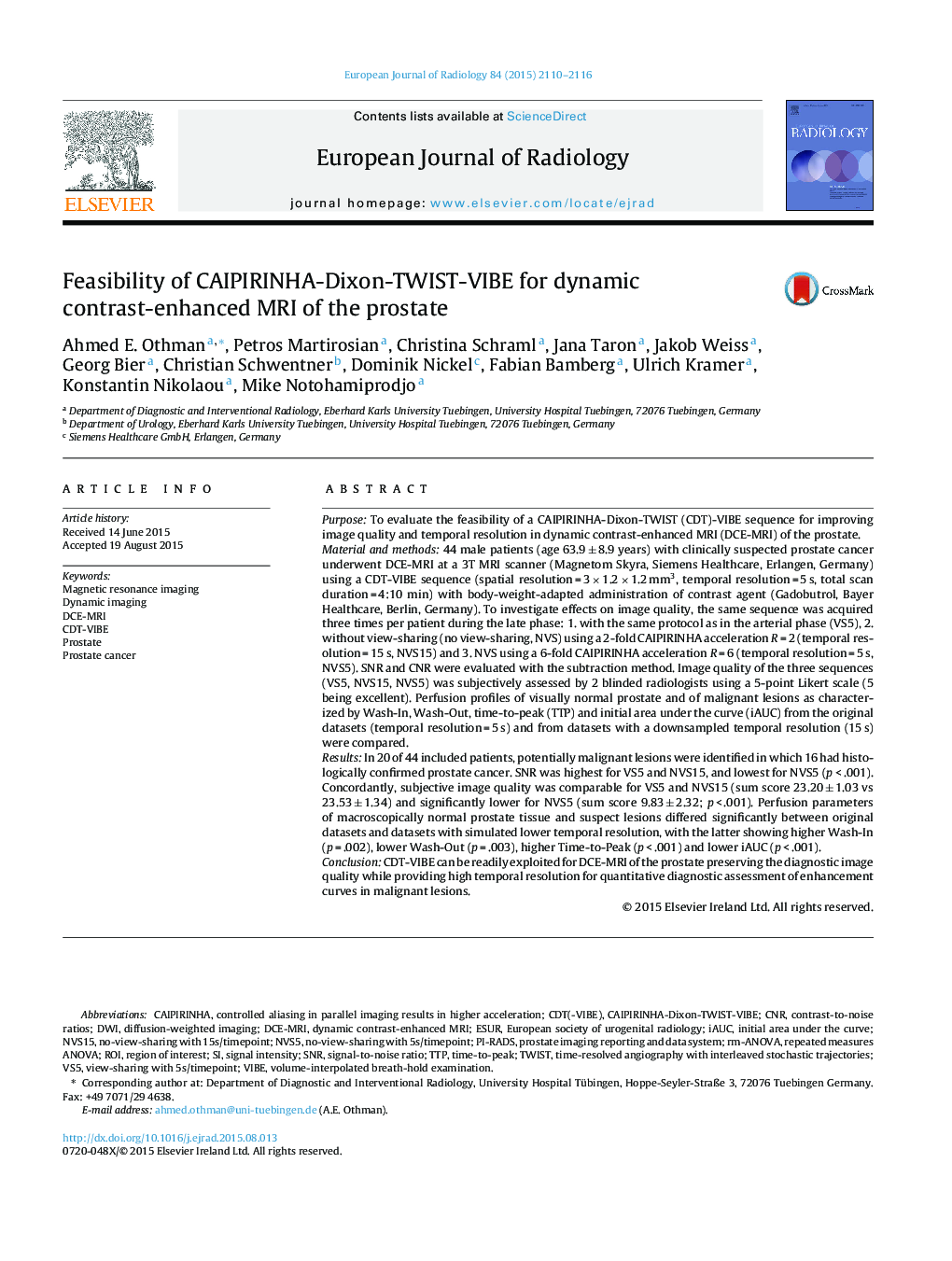| کد مقاله | کد نشریه | سال انتشار | مقاله انگلیسی | نسخه تمام متن |
|---|---|---|---|---|
| 4225005 | 1609748 | 2015 | 7 صفحه PDF | دانلود رایگان |

PurposeTo evaluate the feasibility of a CAIPIRINHA-Dixon-TWIST (CDT)-VIBE sequence for improving image quality and temporal resolution in dynamic contrast-enhanced MRI (DCE-MRI) of the prostate.Material and methods44 male patients (age 63.9 ± 8.9 years) with clinically suspected prostate cancer underwent DCE-MRI at a 3T MRI scanner (Magnetom Skyra, Siemens Healthcare, Erlangen, Germany) using a CDT-VIBE sequence (spatial resolution = 3 × 1.2 × 1.2 mm3, temporal resolution = 5 s, total scan duration = 4:10 min) with body-weight-adapted administration of contrast agent (Gadobutrol, Bayer Healthcare, Berlin, Germany). To investigate effects on image quality, the same sequence was acquired three times per patient during the late phase: 1. with the same protocol as in the arterial phase (VS5), 2. without view-sharing (no view-sharing, NVS) using a 2-fold CAIPIRINHA acceleration R = 2 (temporal resolution = 15 s, NVS15) and 3. NVS using a 6-fold CAIPIRINHA acceleration R = 6 (temporal resolution = 5 s, NVS5). SNR and CNR were evaluated with the subtraction method. Image quality of the three sequences (VS5, NVS15, NVS5) was subjectively assessed by 2 blinded radiologists using a 5-point Likert scale (5 being excellent). Perfusion profiles of visually normal prostate and of malignant lesions as characterized by Wash-In, Wash-Out, time-to-peak (TTP) and initial area under the curve (iAUC) from the original datasets (temporal resolution = 5 s) and from datasets with a downsampled temporal resolution (15 s) were compared.ResultsIn 20 of 44 included patients, potentially malignant lesions were identified in which 16 had histologically confirmed prostate cancer. SNR was highest for VS5 and NVS15, and lowest for NVS5 (p < .001). Concordantly, subjective image quality was comparable for VS5 and NVS15 (sum score 23.20 ± 1.03 vs 23.53 ± 1.34) and significantly lower for NVS5 (sum score 9.83 ± 2.32; p < .001). Perfusion parameters of macroscopically normal prostate tissue and suspect lesions differed significantly between original datasets and datasets with simulated lower temporal resolution, with the latter showing higher Wash-In (p = .002), lower Wash-Out (p = .003), higher Time-to-Peak (p < .001) and lower iAUC (p < .001).ConclusionCDT-VIBE can be readily exploited for DCE-MRI of the prostate preserving the diagnostic image quality while providing high temporal resolution for quantitative diagnostic assessment of enhancement curves in malignant lesions.
Journal: European Journal of Radiology - Volume 84, Issue 11, November 2015, Pages 2110–2116